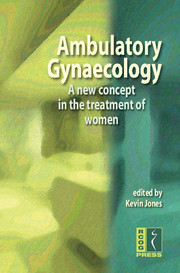Book contents
- Frontmatter
- Contents
- ABOUT THE AUTHORS
- ABBREVIATIONS
- PREFACE
- Chapter 1 Introduction
- Chapter 2 Anaesthesia and analgesia for outpatient gynaecology
- Chapter 3 Colposcopy services
- Chapter 4 Abnormal uterine bleeding
- Chapter 5 Endometrial ablation
- Chapter 6 Urogynaecology: urinary incontinence and genital prolapse
- Chapter 7 Infertility
- Chapter 8 Early pregnancy units and emergency gynaecological services
- Chapter 9 Pelvic utrasound and interventional radiology
- Index
Chapter 4 - Abnormal uterine bleeding
Published online by Cambridge University Press: 05 June 2014
- Frontmatter
- Contents
- ABOUT THE AUTHORS
- ABBREVIATIONS
- PREFACE
- Chapter 1 Introduction
- Chapter 2 Anaesthesia and analgesia for outpatient gynaecology
- Chapter 3 Colposcopy services
- Chapter 4 Abnormal uterine bleeding
- Chapter 5 Endometrial ablation
- Chapter 6 Urogynaecology: urinary incontinence and genital prolapse
- Chapter 7 Infertility
- Chapter 8 Early pregnancy units and emergency gynaecological services
- Chapter 9 Pelvic utrasound and interventional radiology
- Index
Summary
Introduction
The aim of a one-stop service for abnormal uterine bleeding – menorrhagia and postmenopausal bleeding – is to provide rapid access, ultrasound-based clinics for women, where a see-and-treat management philosophy is provided.
This approach allows abnormal uterine bleeding to be dealt with efficiently, on an outpatient basis, often with just one visit. Repeat visits for consultations and investigations can thus be avoided, as may hospital admissions. The aim is to supply a diagnostic and management plan at the same visit. For almost all women, this involves undergoing a transvaginal ultrasound scan (TVUS). Some may need an endometrial biopsy, or an outpatient hysteroscopy. The use of saline hydrosonography may also be helpful. If further treatment is required, women can be offered medical therapy with a progestogen-containing intrauterine system (Mirena®, Schering Health Care Ltd, Burgess Hill, UK). With the development of second-generation devices, endometrial ablation can be performed in the outpatient setting in selected patients. If outpatient treatment is not possible, women can be treated in the day surgery unit. Women with malignant disease can be fast-tracked to the oncology multidisciplinary team for treatment.
Epidemiology, guidelines and national targets
Menorrhagia
In the UK, 5% of women of reproductive age present to their family doctor annually seeking help for menorrhagia. The majority of women have no underlying pathology detected on investigation by the gynaecologist. In such circumstances, women are diagnosed as having dysfunctional uterine bleeding (DUB). The RCOG reports that 42% of the 90 000 hysterectomies performed each year in the UK are for DUB.
- Type
- Chapter
- Information
- Ambulatory GynaecologyA New Concept in the Treatment of Women, pp. 36 - 53Publisher: Cambridge University PressPrint publication year: 2008



